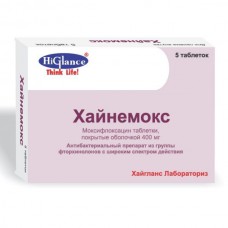Expiration date: 01/2025
Composition:
Each tablet film coated contains:
active substance: moxifloxacin hydrochloride 436,30 mg (equivalent to moxifloxacin 400 mg)
excipients: corn starch – 52 mg; sodium lauryl sulfate – 7.5 mg; purified talc, 15 mg; magnesium stearate – 6.5 mg; carboximetilkrahmal sodium 20 mg; silicon dioxide colloidal anhydrous – 3.5 mg; croscarmellose sodium – 6.5 mg; microcrystalline cellulose – of 130.7 mg.
the shell: Opadry white (85G58977) Make-Colorcon (polyvinyl alcohol, titanium dioxide, talc, macrogol - 3000, lecithin (soy)) – 17,32 mg; iron oxide red – 0,68 mg.
Description:
Pinkish-red, oval, biconvex, tablets scored, film-coated. In the fracture of a homogeneous mass of white to light yellow with a greenish tint.
Pharmacological properties
Pharmacodynamics
Moxifloxacin is a bactericidal antibiotic of broad-spectrum-generation fluoroquinolone number, 8-methoxypsoralen. Inhibits topoisomerase II and topoisomerase IV, violates supercoiling and cross-linking of DNA breaks, inhibits DNA synthesis, causes profound morphological changes in cytoplasm, cell wall and membranes of the susceptible organisms. Minimum bactericidal concentrations of moxifloxacin in General, is comparable to its minimum inhibitory concentrations (MIC).
The mechanisms leading to the development of resistance to penicillins, cephalosporins, aminoglycosides, macrolides and tetracyclines do not violate the antibacterial activity of moxifloxacin. Cross-resistance between these groups of antibacterial drugs and moxifloxacin is not observed. So far there were no cases of plasmid stability. The overall frequency of development of resistance is very small (10-7 – 10-10). Resistance to moxifloxacin develops slowly by multiple mutations. Repeated exposure of moxifloxacin on microorganisms at concentrations lower than the MIC accompanied by only a slight increase MICK. There are cases of cross-resistance to chinolones. However, some resistant to other hinolonam gram-positive and anaerobic micro-organisms are really sensitive to moxifloxacin.
Moxifloxacin active in vitro against wide range of gram-negative and gram-positive organisms, anaerobes, acid-fast bacteria and atypical bacteria such as Mycoplasma spp. Chlamydia spp., Legionella spp. as well as bacteria resistant to beta-lactam and macrolide antibiotics.
Spectrum antibacterial activity of moxifloxacin includes the following microorganisms:
Sensitive:
Gram-positive
Gardnerella vaginalis, Streptococcus pneumoniae* (including strains resistant to penicillin, and strains with multiple resistance to antibiotics), Streptococcus pyogenes (group a)* Streptococcus milleri group (S. anginosus*, S. constellatus* S. intermedius*), a group Streptococcus viridans (S. viridans, S. mutans, S. mitis, S. sanguinis, S. salivarius, S. thermophilus, S. constellatus), Streptococcus agalactiae, Streptococcus dysgalactiae, Staphylococcus aureus (including strains sensitive to methicillin)*, coagulase-negative staphylococci (S. cohnii, S. epidermidis, S. haemolyticus, S. hominis, S. saprophyticus, S. simulans), including strains sensitive to methicillin.
Gram-negative
Haemophillus influenzae (including strains producing and reproducirse beta-lactamase)*, Haemophillus parainfluenzae*, Moraxella catarrhalis (including strains producing and reproducirse beta-lactamase)*, Bordetella pertussis, Legionella pneumophila, Acinetobacter baumanii, Proteus vulgaris.
Anaerobes
Fusobacterium spp., Porphyromonas spp., Prevotella spp. Propionibacterium spp.
Atypical
Chlamydia pneumoniae*, Chlamydia trachomatis*, Mycoplasma pneumoniae*, Mycoplasma hominis, Mycoplasma genitalium, Legionella pneumophila*, Coxiella burnettii.
Moderately sensitive:
Gram-positive
Enterococcus faecalis* (only the strains sensitive to vancomycin and gentamycin), Enterococcus avium*, Enterococcus faecium*.
Gram-negative
Escherichia coli*, Klebsiella pneumoniae*, Klebsiella oxytoca, Citrobacter freundii*, Enterobacter spp. (E. aerogenes, E. intermedius, E. sakazakii), Enterobacter cloacae*, Pantoea agglomerans, Pseudomonas fluorescens, Burkholderia cepacia, Stenotrophomonas maltophilia, Proteus mirabilis*, Morganella morganii, Neisseria gonorrhoeae*, Providencia spp. (P. rettgeri, P. stuartii).
Anaerobes
Bacteroides spp. (B. fragilis*, B. distasonis*, B. thetaiotaomicron*, B. ovatus*, B. uniformis*, B. vulgaris*), Peptostreptococcus spp., Clostridium spp.
Resistant:
Gram-positive
Staphylococcus aureus (resistant to methicillin/ofloxacin strains)+, coagulase-negative staphylococci (S. cohnii, S. epidermidis, S. haemolyticus, S. homnis, S. saprophyticus, S. simulans), the methicillin resistant strains.
Gram-negative
Pseudomonas aeruginosa
*- Sensitivity to moxifloxacin is confirmed by clinical data.
+ The use of the drug Gynemax not recommended for the treatment of infections caused by strains of S. aureus resistant to methicillin (MRSA). In the case of suspected or confirmed infections caused by MRSA, should prescribe treatment appropriate antibacterial drugs.
Pharmacokinetics
Absorption: After oral administration of moxifloxacin rapidly and almost completely absorbed from the gastrointestinal tract (GIT). Food intake has little effect on the speed and completeness of absorption. Bioavailability of 91%. The maximum concentration of moxifloxacin in plasma after ingestion in a dose of 400 mg is reached within 0.5 – 4 hours and is equal to 3.1 mg/L.
Distribution: Moxifloxacin is rapidly distributed in tissues and organs. Connection with plasma proteins (mostly to albumin) is approximately 45%. The volume of distribution is approximately 2 l/kg.
High concentration of moxifloxacin, exceeding those in the plasma, are achieved in the lung tissue (i.e. alveolar macrophages) in the bronchial mucosa, nasal sinuses, and exudate from skin lesion inflammation. Also, high concentrations of moxifloxacin are in the tissues of the abdominal cavity, peritoneal fluid and female genital organs. In the interstitial fluid and in the saliva of moxifloxacin determined in a free, not associated with the protein form, in concentrations higher than in plasma.
Metabolism: After passing the 2nd phase of biotransformation moxifloxacin is excreted by the kidneys and gastrointestinal tract in unchanged form and in the form of inactive glucuronides and sulfasalizine. Moxifloxacin no biotransformation by microsomal cytochrome P450.
Excretion: the elimination half-life of moxifloxacin is approximately 12 hours. The average total body clearance after administration at a dose of 400 mg is from 179 to 246 ml/min, About 22 % of a single dose (400 mg) is excreted unchanged by the kidneys, about 26% intestinal.
Pharmacokinetics in different patient groups
Age, gender and ethnicity. In the study of moxifloxacin pharmacokinetics in men and women, the differences in 33% of the metrics AUC and Cmax. The absorption of moxifloxacin was not dependent on gender. Differences in AUC and Cmax was caused rather by the difference in weight than the floors and are not considered clinically significant. No clinically significant differences in pharmacokinetics of moxifloxacin in patients of different ethnic groups and different sexes.
Children. Pharmacokinetics of moxifloxacin in children have not been studied.
Renal failure. There were no significant changes in the pharmacokinetics of moxifloxacin in patients with impaired renal function (including patients with creatinine clearance <30 ml/min/1.73 m2) and patients on continuous hemodialysis and prolonged outpatient peritoneal dialysis.
The liver dysfunction. The concentration of moxifloxacin in patients with impaired liver function (classes a and b according to the classification of child-Pugh) had no significant differences compared to that in healthy volunteers or patients with normal liver function (for use in patients with liver cirrhosis see "Contraindications").
Indications for use
Infectious-inflammatory diseases caused by sensitive to moxifloxacin microorganisms:
- community-acquired pneumonia, including community acquired pneumonia caused by strains of microorganisms with multiple resistance to antibiotics*;
- exacerbation of chronic bronchitis;
- acute bacterial sinusitis;
- uncomplicated and complicated infections of skin and soft tissues (including infected diabetic foot);
- complicated intra-abdominal infections, including polymicrobial infections, including intra-abdominal abscesses;
- uncomplicated inflammatory disease of the pelvic organs (including salpingitis and endometritis).
* Streptococcus pneumoniae with multiple resistance to antibiotics include strains resistant to penicillin, and strains resistant to two or more antibiotics of groups such as penicillins (if MIK ? 2 µg/ml), cephalosporin II generation (cefuroxime), macrolides, tetracyclines and trimethoprim/sulfamethoxazole.
Contraindications
hypersensitivity to moxifloxacin, to other hinolonam or other components of the drug;
- children up to age 18;
- allergic reactions to peanuts or soy;
- lesions of the tendons at the earlier treatment quinolones;
- concomitant use of drugs that lengthen the QT interval (including antiarrhythmic drugs of class IA, III) – see "Interactions with other drugs";
- the use of moxifloxacin causes QT prolongation. In this regard, the use of moxifloxacin is contraindicated in patients in the following categories: congenital or documented acquired QT prolongation; electrolyte disturbances, particularly neskorrigirovannoe hypokalaemia; clinically relevant bradycardia; clinically relevant heart failure with reduced ejection fraction of the left ventricle; a history of rhythm disturbance, accompanied by clinical symptoms;
- patients with impaired liver function (class C classification for child-Pugh) and elevation of transaminases more than five times the upper limit of normal;
- pregnancy, lactation.


